Most people think of only Thailand or Bali for beaches and islands, but if you ask me, Palawan is on another level!
With its lush rainforests, white sand beaches, hidden caves and lagoons, and numerous incredible snorkel- and dive sites, Palawan is one of the true highlights of The Philippines.
I’ll share the most common travel route through Palawan with tips for all key stops along the way, including El Nido and Coron.
Plan your Palawan trip
El Nido or Palawan?
Your first decision is whether to stay only in El Nido or to explore several destinations in Palawan.
El Nido is easily the most scenically located town on the island, nestled between steep limestone peaks and hugging a gorgeous bay. Boat tours here can take you to hidden beaches, coves, and gorgeous lagoons. It is usually the main place people want to go.
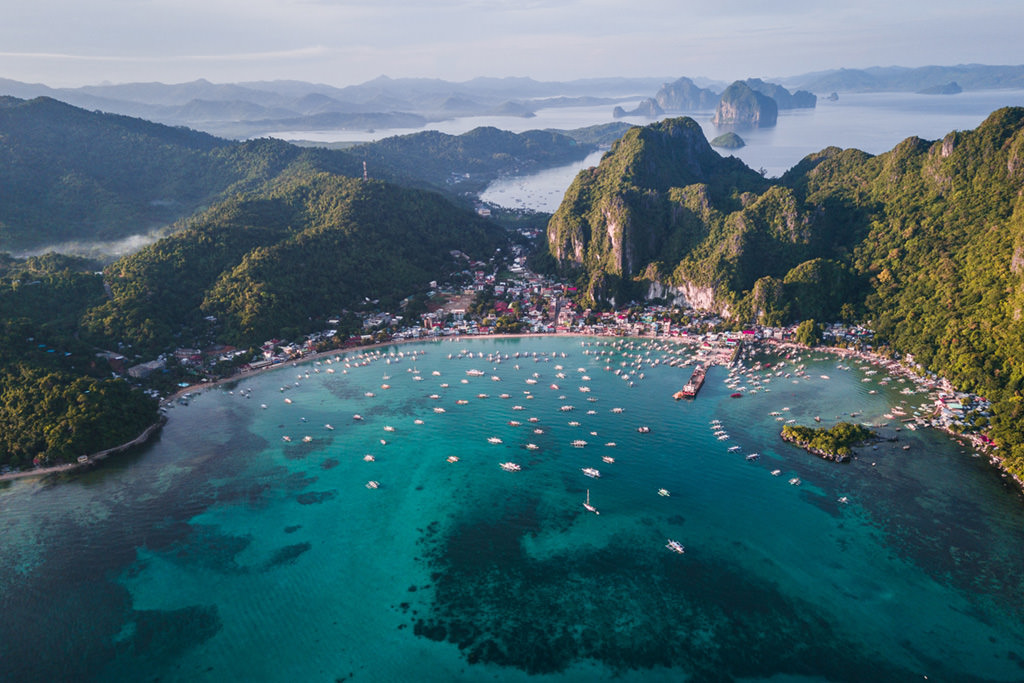
That said, El Nido is also the epicenter of tourism in Palawan and so it can be quite packed at times. It’s a bustling backpacker town with numerous lodges and hostels (and small-scale resorts outside the town as well). The bay is often brimming with bangkas, the local catemaran-style boats.
If you have just a few days, El Nido is a great choice. It can be reached directly by plane from Manila and you can use El Nido as a base for day trips to nearby beaches and waterfalls.
If you have 10 to 14 days, you can follow my itinerary to get all the best of Palawan, including El Nido. Places like Port Barton and Coron are blissful and my personal faves.
Palawan itinerary
It’s easy to independently plan your Palawan trip. All transport can be booked online, and local tours can be booked online or in person.
My suggested 10-day itinerary:
| Day | Activities | Accommodation |
|---|---|---|
| Day 1 | Firefly watching | At Home, Puerto Princesa |
| Day 2 | Underground River | Casa Leonora, Sabang |
| Day 3 – 4 | Beach & relaxing | Sunset Colors, Port Barton |
| Day 5 – 7 | Island hopping tour Via Ferrata Canopy Walk Ziplining at Nacpan Beach |
El Gordo, El Nido |
| Day 8 – 10 | Skeleton Wreck Lagoons tour Hike Mt. Tapyas |
Viewpoint Lodge, Coron |
To shorten the trip, you could decide to cut the first few days and focus on El Nido and Coron by flying in straight to El Nido. But I think 10 days is the perfect minimum time to get the most out of Palawan.
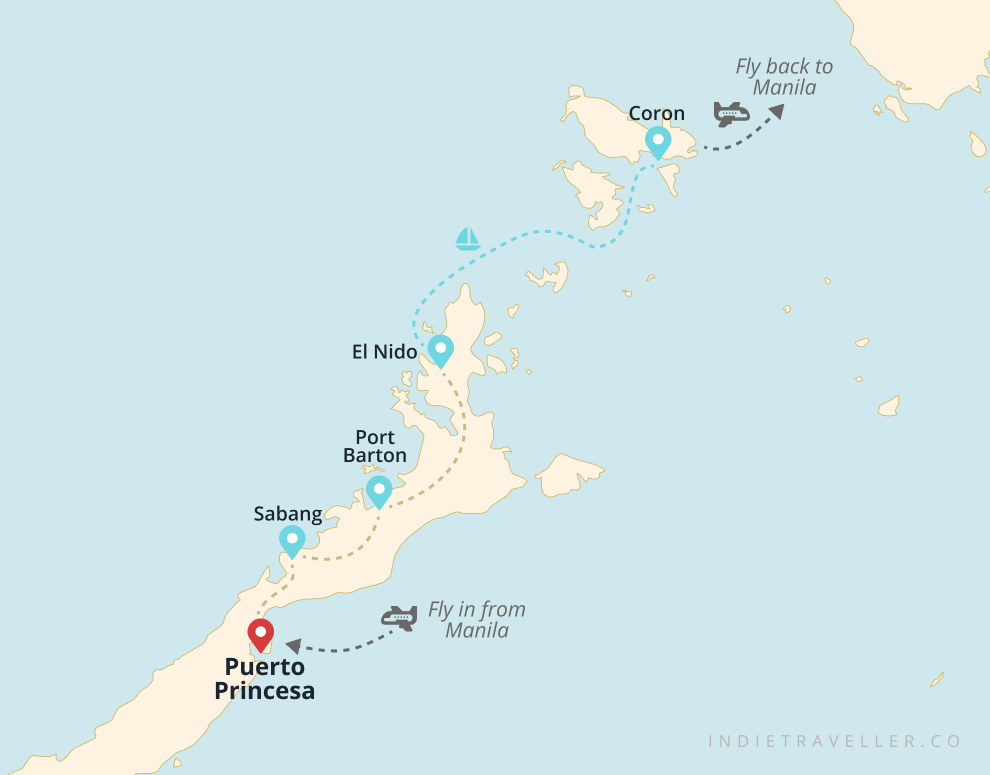
How to get to Palawan
There are no scheduled ferries to Palawan (and they would take too long anyway), so you’ll have to fly. You have three options.
Fly into El Nido
This airport is tiny so you’ll arrive by propellor plane. You can fly with just one carrier, AirSWIFT. This is a very local service, but you can book your Manila to El Nido flight easily using 12Go Asia. Due to a lack of competition, these flights are more expensive.
Fly into Puerto Princesa
The capital has many more flight connections and with larger planes. You can check your flight options at 12Go. This platform is specialized in Asia so they truly list all the options.
Fly into Coron
This is another possibility, though I suggest starting in Puerto Princesa and flying out of Coron.
All flights from Manila to Palawan take roughly 90 minutes.
By the way, there are no direct flights nor any boats connecting Palawan to Indonesia or Malaysia. You must always travel via Manila or Cebu City.
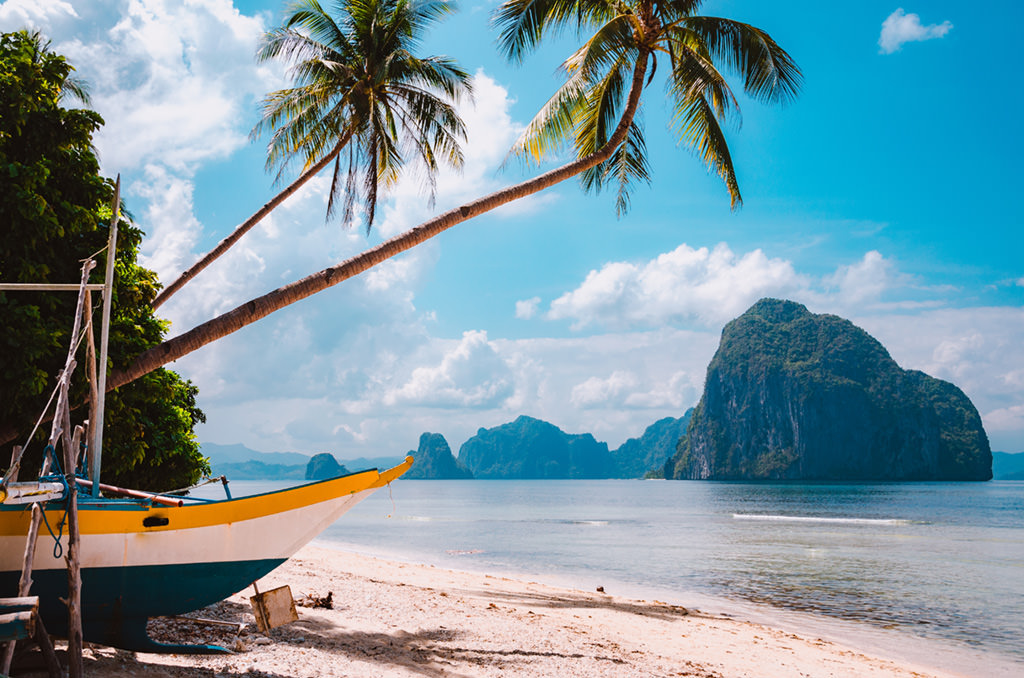
Let’s take a look at the key destinations in Palawan, from south to north:
Puerto Princesa
The gateway to Palawan, worth just a stopover
There isn’t a whole lot to see or do in Palawan’s capital and only city (population: around 200,000). Most people say it’s their least favorite destination along this route. However, it’s still worth spending a night just to enjoy two fun activities.
Firstly, many restaurants serve an iconic dish known as tamilok (or woodworm), a slimy mollusc found on mangrove trees. It may not sound exactly appealing but there’s a great chance you’ll be bullied into tasting it! It doesn’t taste bad, just a bit weird – like creamy, slimy jelly. Think oyster, only richer and a bit saltier. Another unusual thing to try is croc sisig, which is minced crocodile meat served on a sizzling plate.
At night, consider taking a firefly-watching tour to Iwahig River. You can rent a boat and enjoy the serenity of paddling through the darkness, until reaching the spot where the fireflies dance around the mangroves. I don’t often call travel experiences “magical” but this one truly deserves the label.
However, ignore the island-hopping tours to Honda Bay. While I still had a fun time, the other islands in Palawan will blow these out of the water (so to speak). I feel these tours are more for Puerto Princesa residents who want a fun day out, while not being all that impressive to travellers who have come from afar to see the best of Palawan.
Sabang & Underground River
Laid-back beach town next to a World Heritage Site
Millions of years ago, the Puerto Princesa Underground River snaked its way underneath the St. Paul Mountain Range and became one of the few of its kind that flows directly to the sea. It is now a protected area that has been recognized by UNESCO as World Heritage Site.
The cave boasts 8km of underground channels, about half of which can be explored. You can take a day trip from Puerto Princesa to the river cave, but it’s also a nice option to stay in the town of Sabang. More than the creamy sand and the clear waters, I was amazed by the seclusion of the place. You can sip fresh coconut while watching the waves crash on the shore.
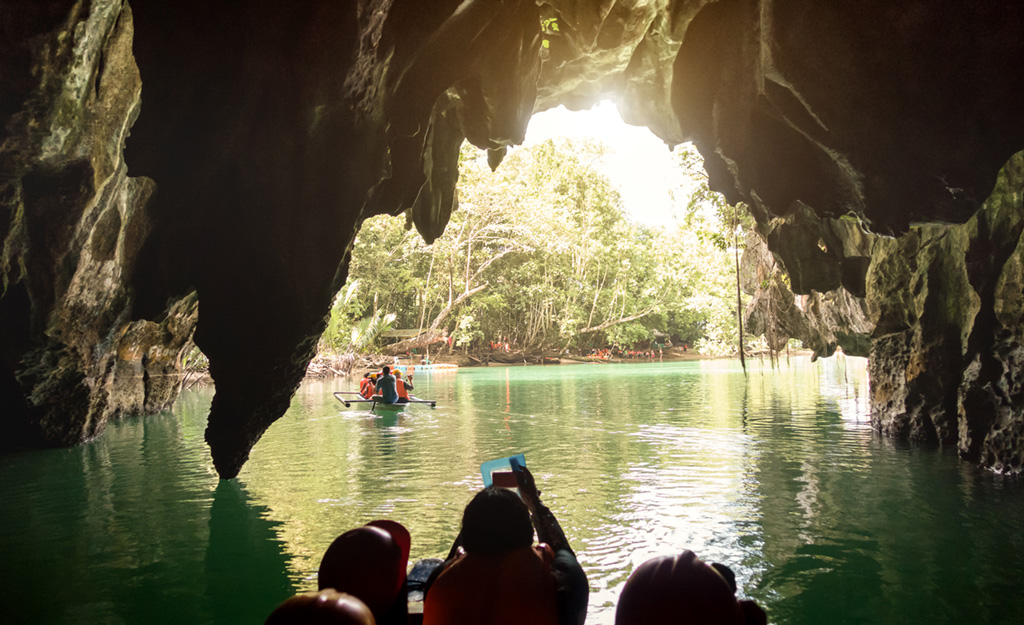
In Sabang you can also go hiking, bird watching, paddling across the mangrove forest, and seeing wild animals in their natural habitat. I loved taking an early morning paddle boat tour of the mangroves and seeing numerous birds, yellow-banded snakes, and reptilians.
As you walk along the beach, crabs of different sizes and colors scatter into their holes in the sand. Near the cave entrance were several wild monkeys and giant monitor lizards. The area definitely felt quite wild and alive!
It gets quiet after the day trippers have left, and I enjoyed spending a bit of extra time here, so I think it can be worth staying the night.
How to visit the underground river
There are two ways to the entrance – taking a 6-kilometer trek through rich rainforest or taking a 20-minute scenic boat ride overlooking karst mountains. Both begin in Sabang. Visitor numbers are restricted by a daily quota, so if you don’t get a tour with a permit included, you’ll need to get your permit in Puerto Princesa a day before. You can book this day trip from Puerto Princesa, but if you’re staying in Sabang, it’s better to book locally.
It’s a short but eerie and magical 45-minute boat ride through the alternating huge chambers and narrow channels of the cave. Stalagmite and stalactite formations are said to resemble figures ranging from Jesus Christ to Hollywood stars. An audio guide is available for those who want to understand the cave better, but maybe you’d much rather enjoy the sounds of water dripping, swallows chirping, and bats flying above.
Port Barton
A quiet and back-to-basics village where you can be in nature
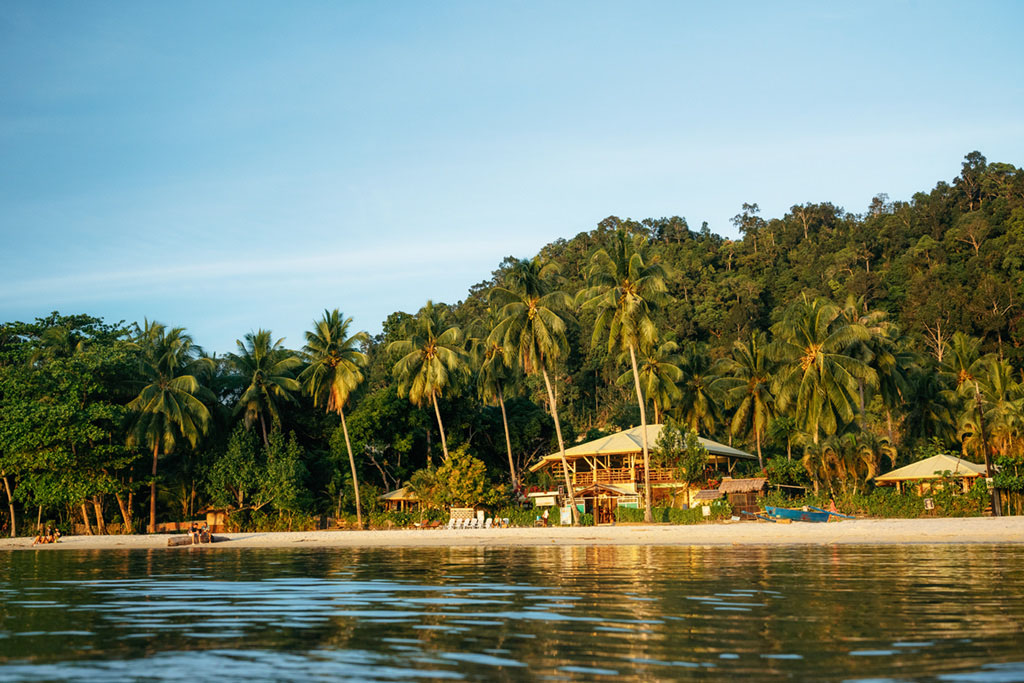
Get away from it all and spend your days thinking about nothing.
Port Barton is a less-known spot that can be reached after a 3 to 4-hour land travel from Puerto Princesa. It’s a truly unspoiled and relaxing place.
It’s a bit more basic in its accommodation offerings and attracts mainly backpackers and down-to-Earth travellers not needing many luxuries, but if you can appreciate a remote place with lots of natural beauty, then this might just be your little slice of paradise.
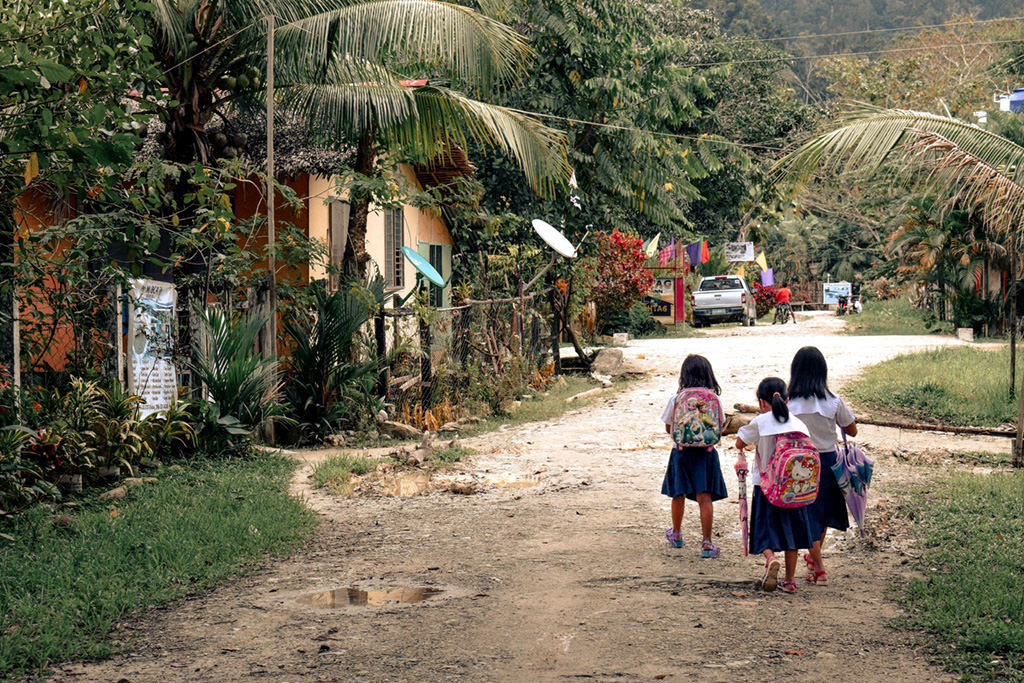
Upon arrival, you will be welcomed by a strip of white sand beach dotted by palm trees and nipa huts. Be sure to ask a guide to take you to Pamuayan Falls, a 1.5-hour trek through the jungle and into a cool natural basin.
There are also pristine nearby islands easily accessible by boat. Like in El Nido, there are four island hopping tours you can take (A, B, C and D).
Port Barton used to be off-grid but now has 24-hour electricity. Internet access remains limited and there is no ATM, so bring sufficient cash. Go here for a remote stay surrounded by nature.
El Nido
Epic karst landscapes and enchanting lagoons
Nestled among tall karst cliffs and with two adjacent beaches, El Nido is easily one of the most scenic locations in the Philippines.
Save for the number of tourists, which admittedly can sometimes be overwhelming, this town deserves all the glory.
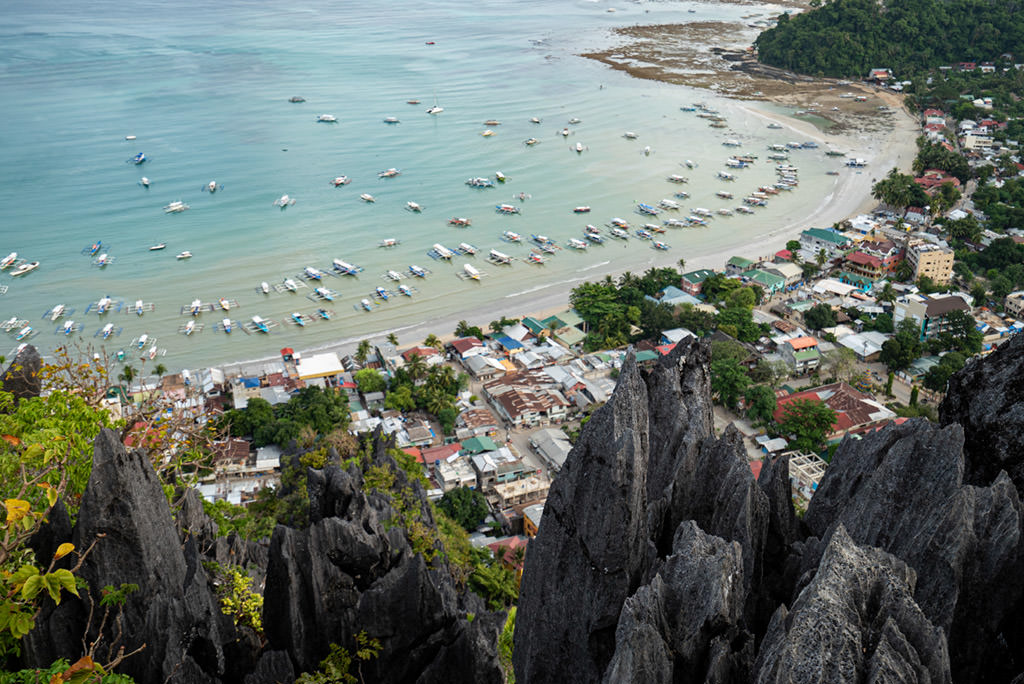
If you arrive in El Nido expecting it to be overrated, you will surely be blown away by the epic scenery. I can say it’s one of the most beautiful places I’ve visited in Asia.
The town is changing quickly, however. It became ‘discovered’ circa 2012 and tourism has been on an exponential growth path ever since. The pandemic caused a big reset from which it’s recovering, but I do wonder what happens to El Nido in the future if development is not properly managed.
But such worries aside, El Nido is not a place to miss. The bustling town is a fun place to stay with wonderful bay views, though if you’d like more seclusion, simply book accommodation along the nearby Calaan Beach or the more distant Nacpan Beach (about a 25 minutes’ drive north).
You can hike up to Mount Taraw, the ridge that backs El Nido, for some stunning vistas. Up this way is also a via ferrata canopy walk that makes for a fun and active adventure.
But the main attractions are the nearby lagoons and islands. You can choose between 5 tours, labelled from A to E. The itineraries have all been standardized in order to regulate visitor numbers and to have a variety of places to go.
Based on my own experiences and comparing notes with other travellers, Tour A and Tour C seem to be the most widely favored. The tours include lunch – freshly caught seafood cooked on an island and served with tropical fruits. You can get a nice breakdown of these tours here.
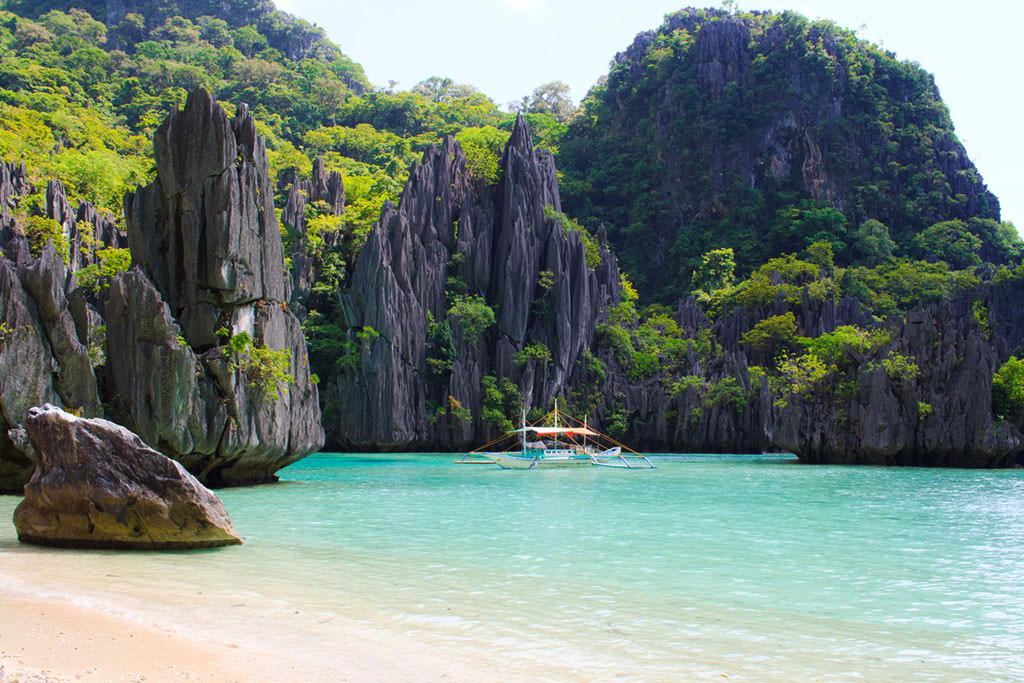
One of the highlights for me was the Secret Beach. You will need to jump off the bangka and swim towards a craggy cliffside. Look closely and you will see a small hole you can swim through; emerge on the other side you will discover a hidden beach entirely surrounded by pointy rocks as tall as buildings.
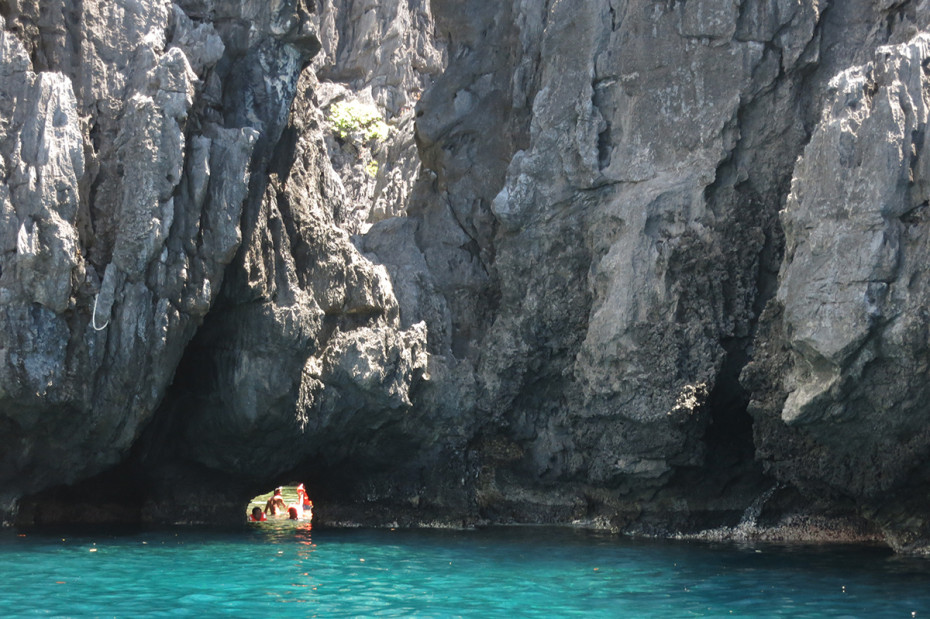
Put on a snorkelling mask and you will see wonderful corals with countless fishes below… look back up and you are back in this rockface cathedral. While this sight can get busy, it is one of the most memorable as well.
After some days in El Nido, it’s finally time to go to the island of Busuanga.
How to get to Busuanga
From El Nido, it is very easy to go to Busuanga. You can take a ferry from the west side of El Nido’s main beach, which takes about 5 hours to get to Coron Town on Busuanga. Be sure to book your tickets in advance to make sure you get a seat on your desired day. There are usually just 1 or 2 ferries per day leaving around mid-day.
Another option is to go on a private trip that will give you a chance to stop on a number of remote islands along the way. One some of these trips, you can even bring a hammock and sleep under the stars! I sadly didn’t have the chance to do this, but when I return to Palawan I will 100% go on one of these cruises. Check out Tao Expeditions or El Nido Paradise.
Busuanga Island & Coron
Breathtaking views, coral gardens, and rich history
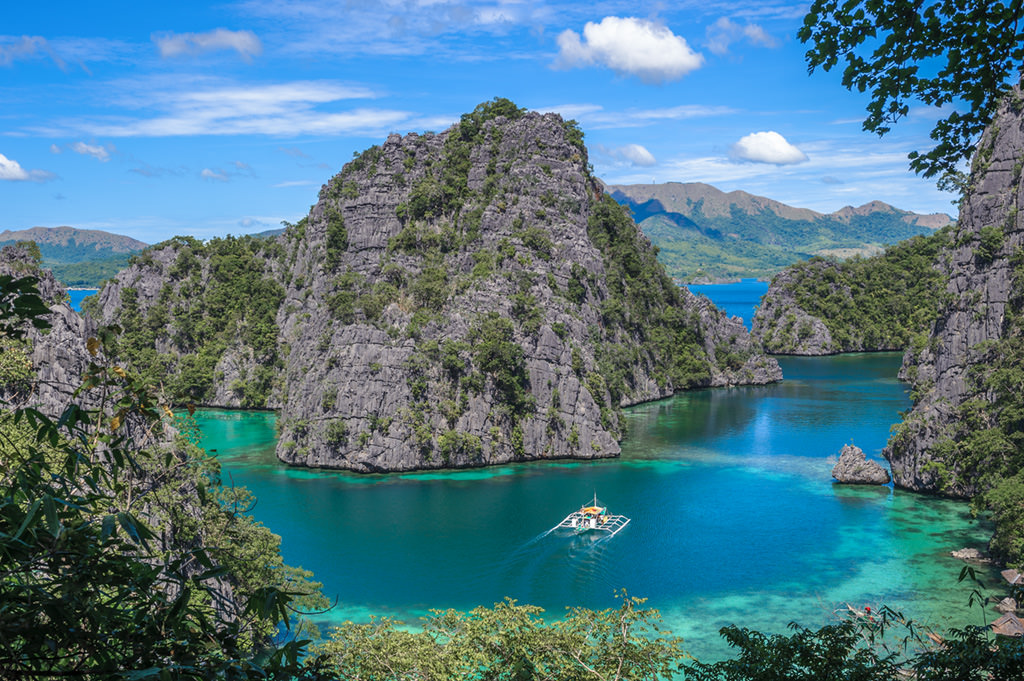
Coron offers some similar attractions to El Nido, but with tourism development a couple of steps behind it.
I ultimately liked Coron a bit more than El Nido. Although Coron Town itself is not as scenic, the lagoons are stunning and the island interior is great for hiking. I enjoyed hiking up to Mount Darala, the island’s highest point, where you will get 360-degree views of the bay.
Busuanga Island is divided into two sections – Busuanga and Coron – the latter being the major tourist stop. Busuanga and nearby islands are home to lush rainforests, natural springs, and a whole new world underwater. You won’t find a lot of beaches here, but you can spend days on end exploring the many lagoons, dive spots, and swimming with rich marine life.
Like elsewhere, there are several standardized tour itineraries to choose from, labelled from A to C. If you do Island Hopping Tour B, you’ll stop at the Skeleton Wreck, the remains of a Japanese supply ship. At its shallowest, it’s submerged only 5 meters blow the surface, making it perfect for snorkelling.
Coron is also famous for wreck diving, thanks to the number of Japanese ships that sunk in these waters during World War 2. Back in 1944, the US Navy launched a coordinated attack on the Imperial Japanese Navy docked in Manila Bay. The fleet tried to escape and hide in Coron but they were tracked and eventually gunned down in their supposed shelter. Now, these shipwrecks are covered with colorful corals teeming with many different kinds of fish.
And that wraps it up for our highlights of Palawan, a region many consider a true paradise! A 90-minute flight from Busuanga Airport will take you straight back to the capital, from where you can go home or explore other regions of the Philippines.
Some links may be affiliate links, meaning I may earn commission from products or services I recommend. For more, see site policies.
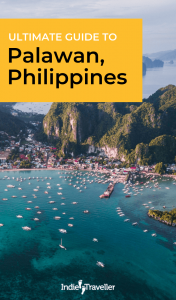

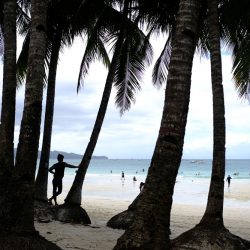




Great itinerary, but it’s missing Culion! Just a short boat ride from Coron, Culion island used to be a leper colony. Not many travelers go this way. If you do, friendly local pastor Hermie will show you around, tell you more about the dark (recent!) history of the island and introduce you to the last remaining leprosy survivors. He can also arrange accommodation with families on the other end of the island. Any local will point you to him.
Culion was one of our favorite of the beaten track destinations!
Excellent tip!
Great post! All my questions are already answered. Now I can easily plan my upcoming vacation to Palawan
Hey marek! Sounds like your the guy to ask 😉 i’m going to palawan in dec for 16 days, flying man -pps return.. would you recommend hiring a bike the whole time to get about? I want to stop a few times on the way to el nido (pps,sabang,sanvincete/portbarton, taytay,elnido/coron. Is this all doable via bus? Also, are there cash points around port barton or el nido? I’ve been told to take all cash out at pps but dont want to carry loads around with me… any advice would be great. Female, traveling alone, 36.
I remember the road from PPS to Sabang/El Nido being pretty boring, but yeah you could do it by bike. All those places are doable by bus or jeepney (local transport). There are a bunch of cash points / ATMs in El Nido these days 🙂
This is my third time to visit Palawan. It will be a private tour of 15 days starting on Dec. 21 from PPS. I had been to coron, Elnido ,and underground river ,so what do you say to stop at some nice place over there? I intend not to go to both the north and south tip–including Coron and Elnido. Port barton is good , and Roxas could be very similar? And this is also my 9th time to visit Philippines. 15 dAYS all together. I need your advise for some quiet and nice area with public transportation available Thank you. Oh I am 70 , and male.
Thank you very much for this marek!
I am planning to go on february 2020 for the hole month. Any planning ideas mate?
Hi. I just wanna ask how did you have an organized tour? did you get tour packages? and if you did. What travel and tours can you recommend? Thank you very much.
Hey Kaya. For the island hopping in El Nido, all the day tours are standardized. They’re called Tour A, B, C and D and all the companies adhere to these routes. I did A and C and loved them. You can book them very easily when you get there.
Hi Marek! My Hubby and I are travelling to the Philippenes in Feb 2019. We will land in Manila and from there plan to visit Palawan / El Nido / Coron. In what order should we visit them considering the internal travel facilities? What is the most ideal way to get around these three places from Manila?
Thanks!
Hey Manasi. Well… I kinda answer that above 😉
Manila -> fly to Puerto Princesa > Palawan > El Nido > Coron > fly to Manila
This is a reliable way of doing this route and I think it puts it in a nice order too.
Hey Marek,
We are looking to fly from near the rice terraces banaue and We will have roughly 4 days in Palawan.. where and what would suggest with such a short time?
We also have plans to see cebu maybe 4 days?
We’ve left planning a little last minute as time has just flown by.
Any advice would be appreciated.. if we are being silly giving ourselves to !ittle time in each place?
Hey Jemima. With 4 days in Palawan I’d probably just do El Nido and the surrounding area. I’d personally fly around less – e.g. you could spend more days in Palawan and see lots more there without rushing, and spend less time going to airports.
Hi Marek, I know you wrote this a while ago – but it was helpful for me! I do have one odd Q perhaps… but personally, did you think this was truly one of the best places / beaches? Is it worth us taking 14 hour trips to visit?
Appreciate your feedback on this one.
Thanks
Malak
Hey Malak. It’s difficult to say what is or isn’t worth it – I just don’t know where you’ve travelled before or how much time you have! All I can say that I genuinely think these were some of the best lagoons, bays, and islands I’ve seen in SEA, and the beaches were amazing too 🙂
Marek do you know if Mid July will be a right time to visit? Thanks in advance.
It’s in the rainy season, so expect daily heavy showers. But it’s still possible to see and do everything if you can be a bit flexible (rains can be heavy but short).
My husband and i would be visiting Palawan for 5 nights. Really would like to just chill with a cold beer on a beach….which location would you suggest when flying in from Cebu….
Hi Marek!
Just have a question about the Tour trip in El Nido, Do I have to book it in advance or I can just go there and book it the day before or on the same day booking?
Thanks
You should be fine booking the day before in El Nido 🙂
Hi Marek!
My boyfriend and I are planning to go to Palawan this coming May. I’m noting everything in advance and I’m still unsure where to go first among the two: El Nido or Coron. Which one is nearer to Palawan? We are staying for 5 days, is that enough to tour around these places? Thank you.
Jaz
Both are in the province of Palawan – but El Nido is on the main island, whereas Coron is on its own island. I don’t think there’s a right or wrong order to see them – both are amazing!
5 days can be sufficient, especially if that’s not counting your travel days in & out of palawan.
Hi Marek!
We are flying to Puerto Princesa on Monday 30th January at 10 a.m. and flying out the next Monday during lunch time. Do you think it is possible for us to go to El Nido and also Corón or is it too much of a hassle? I found a new fast ferry that goes every day and takes only three and a half hours… How many days would you recommend for El Nido and how many for Corón? Thank you!! 🙂
If you have a week, sure, that should be enough – especially with the fast ferry option. I would personally suggest maybe 3-4 days in El Nido and 2 days on Coron.
Hi Marek
This blog is great its been so helpful!! When is the best time of the year to go to Palawan? Looking at going for about 2 weeks. We live in South Africa so thinking of flying to Manila, manila to Puerto p, travel up to el nido, then coron and fly back to manila.
Hi Tish. The dry season runs from Nov to about April so these months are ideal. The other months can be good too (it doesn’t rain all the time in the wet season), though the Philippines does sometimes get intense typhoons during the wet season which you’ll probably want to avoid. 🙂
hi Marek!
I am going to Puerto princesa in 2 weeks and I was wondering if it is possible to see any whale shars or other sea animals at this time of the year there? Also what kind of activities would u recommend?thx for your help 🙂
Hey Marek!
Great blog and beautiful pictures!
Me and 3 friends are gonna go backpacking around asia and the philippines and go Iland hoping. How do we start? and should we prebook hostels and stuff on the ilands or just take it as it comes? thank you 🙂
Hey Johan. It depends how long your trip is. If you’ve got a good amount of time (e.g. not just 1 week), then I recommend booking things one step at a time as you travel. So book place B while you’re staying at place A, place C when you get to place B, etc. That way you keep some flexibility but can still pick the best hostels.
Hi Marek, thanks so much for the great blog. If you only had four days, how would you go about exploring this area? Our first time. On our agenda is snorkeling, SCUBA, eating, and general adventure. And you would recommend booking everything in advance, including where to stay? Any tips to that end? Thanks so much.
Hi Camille. For a 4 day trip I’d definitely book ahead – some tips on this here. There’s snorkeling around Honda Bay and some SCUBA diving as well but it’s said to be better around El Nido. Personally, I’d probably make a beeline straight to El Nido (4 hour drive) and stay there for the whole trip.
Hi Marek! What’s the minimum number of days wouls you recommend to allot for a Palawan trip like you had described above? Or at least just to hit the bare minimums of this trip..
Oof, good question! Absolute bare minimum, I’d say maybe 5 days. You could arrive at Puerto Princesa, go to Sabang the same day, spend a couple of days in El Nido, and then use your final day to go back to Puerto Princesa and fly out from there. (Not enough time for Coron.)
Hi Marek, transportation and expenses -wise would you prefer Boracay or Palawan?
In my opinion: Palawan involves more transportation time, but is cheaper and more authentic (no large scale resorts etc.) 🙂
I’m flying into Puerto Princesa on a Monday at 1 ish and we’re leaving on a Friday mid day. We were thinking about going to EL Nido. But we were thinking it might be to long of a trip. What are your thoughts? to short to go to travel out Nido? We thought we might just stay in puerto princesa.
where is secret beach?
Hi ,
i plan to visit palawan and buracay. Is there any way to go from palawan diractely to buracay ? If not , how can I make it ?
Your best bet is to try and find a flight from Puerto Princesa to Caticlan or Iloilo, then take a bus and boat to Boracay…
I’m planning my trip to the Philippines but not going until next year. I’m traveling alone …. A bit scary! I’m planning to visit Cebu, then fly to Palawan. Are the buses to el nido pretty way to come by? Also would you recommend booking accommodation before I leave or just finding places to stay when I’m there?
Finding a bus to El Nido wasn’t difficult, but I forgot the specifics, sorry! If you’re on a longer trip, I think it can be good to just find places when you get there. In well-travelled places like Puerto Princesa or El Nido, and provided there isn’t a special national holiday or something, this is typically easy. On shorter trips, I usually book ahead more often though just to save time.
Hi Marek,
I was thinking of doing the same route you mentioned but backwards. Flying to Coron, island hopping to El Nido and bus back to Sabang and then to Puerto Princesa. Would this be relatively easy to do? Thank you!
Gaby
Hey Gaby. Yes that route would work just as well, as all the transportation goes both ways. 🙂
Hi Marek,
Wow, those pictures were so beautiful. I’m looking at El Nido, but not sure if the Palawan is safe for a solo traveler (female)?
There are many solo female travellers who go to Palawan, and families too. It’s generally quite a safe area. Be cautious and use common sense as anywhere, of course 🙂
Hi Marek
We are a family of 5 with three kids age 4 – 8, we are flying into Cebu and island hopping from there, do you think it is worth us also flying to El Nido, we would have about 8 days or is the journey too arduous? Thank you so much
Looks beautiful, how long would you recommend travelling Palawan?
I would probably recommend a week at minimum, but you could easily spend much longer.
Beautiful place!
Your beautiful photos just reminded me of how much I enjoyed Palawan when I visited it last spring. Secret beach is truly the best tropical beach I’ve ever been to, too bad the boat tour guy let us stay there only for a couple of minutes, cause if you ask me, I could stay there for the whole day just laying on the beach and admiring the nature.